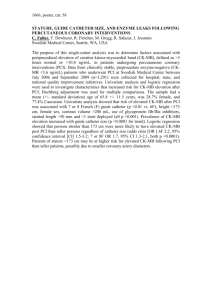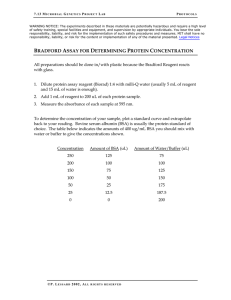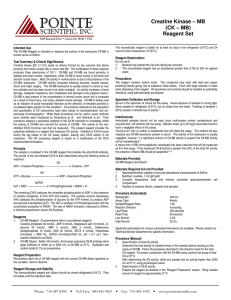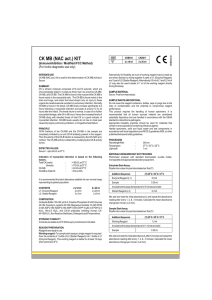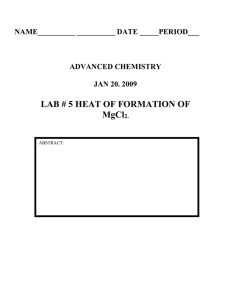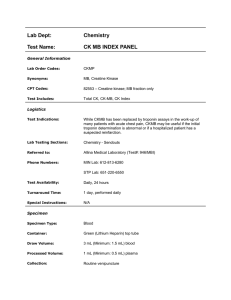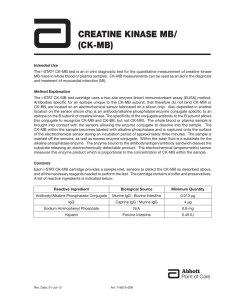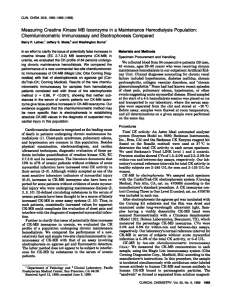Creatine Kinase – MB (CK – MB) Reagent Set
advertisement
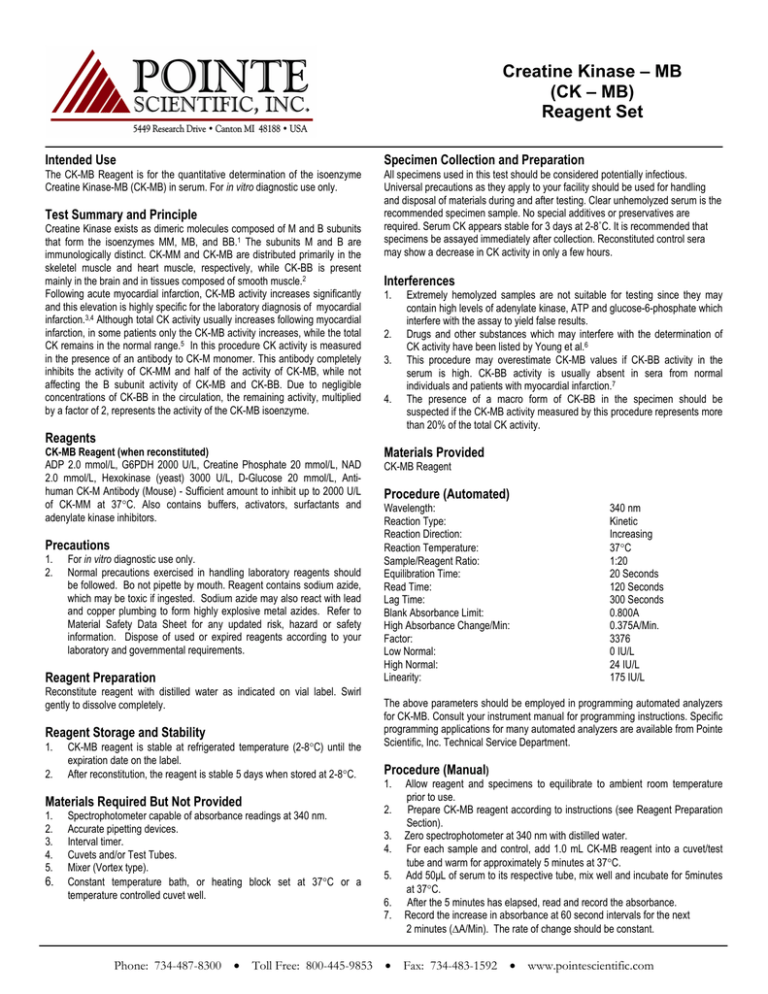
Creatine Kinase – MB (CK – MB) Reagent Set Intended Use The CK-MB Reagent is for the quantitative determination of the isoenzyme Creatine Kinase-MB (CK-MB) in serum. For in vitro diagnostic use only. Test Summary and Principle Creatine Kinase exists as dimeric molecules composed of M and B subunits that form the isoenzymes MM, MB, and BB.1 The subunits M and B are immunologically distinct. CK-MM and CK-MB are distributed primarily in the skeletel muscle and heart muscle, respectively, while CK-BB is present mainly in the brain and in tissues composed of smooth muscle.2 Following acute myocardial infarction, CK-MB activity increases significantly and this elevation is highly specific for the laboratory diagnosis of myocardial infarction.3,4 Although total CK activity usually increases following myocardial infarction, in some patients only the CK-MB activity increases, while the total CK remains in the normal range.5 In this procedure CK activity is measured in the presence of an antibody to CK-M monomer. This antibody completely inhibits the activity of CK-MM and half of the activity of CK-MB, while not affecting the B subunit activity of CK-MB and CK-BB. Due to negligible concentrations of CK-BB in the circulation, the remaining activity, multiplied by a factor of 2, represents the activity of the CK-MB isoenzyme. Reagents CK-MB Reagent (when reconstituted) ADP 2.0 mmol/L, G6PDH 2000 U/L, Creatine Phosphate 20 mmol/L, NAD 2.0 mmol/L, Hexokinase (yeast) 3000 U/L, D-Glucose 20 mmol/L, Antihuman CK-M Antibody (Mouse) - Sufficient amount to inhibit up to 2000 U/L of CK-MM at 37°C. Also contains buffers, activators, surfactants and adenylate kinase inhibitors. Precautions 1. 2. For in vitro diagnostic use only. Normal precautions exercised in handling laboratory reagents should be followed. Bo not pipette by mouth. Reagent contains sodium azide, which may be toxic if ingested. Sodium azide may also react with lead and copper plumbing to form highly explosive metal azides. Refer to Material Safety Data Sheet for any updated risk, hazard or safety information. Dispose of used or expired reagents according to your laboratory and governmental requirements. Reagent Preparation Reconstitute reagent with distilled water as indicated on vial label. Swirl gently to dissolve completely. Reagent Storage and Stability 1. 2. CK-MB reagent is stable at refrigerated temperature (2-8°C) until the expiration date on the label. After reconstitution, the reagent is stable 5 days when stored at 2-8°C. Materials Required But Not Provided 1. 2. 3. 4. 5. 6. Spectrophotometer capable of absorbance readings at 340 nm. Accurate pipetting devices. Interval timer. Cuvets and/or Test Tubes. Mixer (Vortex type). Constant temperature bath, or heating block set at 37°C or a temperature controlled cuvet well. Specimen Collection and Preparation All specimens used in this test should be considered potentially infectious. Universal precautions as they apply to your facility should be used for handling and disposal of materials during and after testing. Clear unhemolyzed serum is the recommended specimen sample. No special additives or preservatives are required. Serum CK appears stable for 3 days at 2-8˚C. It is recommended that specimens be assayed immediately after collection. Reconstituted control sera may show a decrease in CK activity in only a few hours. Interferences 1. 2. 3. 4. Extremely hemolyzed samples are not suitable for testing since they may contain high levels of adenylate kinase, ATP and glucose-6-phosphate which interfere with the assay to yield false results. Drugs and other substances which may interfere with the determination of CK activity have been listed by Young et al.6 This procedure may overestimate CK-MB values if CK-BB activity in the serum is high. CK-BB activity is usually absent in sera from normal individuals and patients with myocardial infarction.7 The presence of a macro form of CK-BB in the specimen should be suspected if the CK-MB activity measured by this procedure represents more than 20% of the total CK activity. Materials Provided CK-MB Reagent Procedure (Automated) Wavelength: Reaction Type: Reaction Direction: Reaction Temperature: Sample/Reagent Ratio: Equilibration Time: Read Time: Lag Time: Blank Absorbance Limit: High Absorbance Change/Min: Factor: Low Normal: High Normal: Linearity: 340 nm Kinetic Increasing 37°C 1:20 20 Seconds 120 Seconds 300 Seconds 0.800A 0.375A/Min. 3376 0 IU/L 24 IU/L 175 IU/L The above parameters should be employed in programming automated analyzers for CK-MB. Consult your instrument manual for programming instructions. Specific programming applications for many automated analyzers are available from Pointe Scientific, Inc. Technical Service Department. Procedure (Manual) 1. 2. 3. 4. 5. 6. 7. Allow reagent and specimens to equilibrate to ambient room temperature prior to use. Prepare CK-MB reagent according to instructions (see Reagent Preparation Section). Zero spectrophotometer at 340 nm with distilled water. For each sample and control, add 1.0 mL CK-MB reagent into a cuvet/test tube and warm for approximately 5 minutes at 37°C. Add 50μL of serum to its respective tube, mix well and incubate for 5minutes at 37°C. After the 5 minutes has elapsed, read and record the absorbance. Record the increase in absorbance at 60 second intervals for the next 2 minutes (ΔA/Min). The rate of change should be constant. Phone: 734-487-8300 • Toll Free: 800-445-9853 • Fax: 734-483-1592 • www.pointescientific.com Creatine Kinase – MB (CK – MB) Reagent Set 8. Determine the average absorbance per minute (ΔA/Min) and then multiply it by the factor 6752 (3376 x 2) for results in U/L Sensitivity: Based on an instrument resolution of A = 0.001, this procedure has a sensitivity of 4 U/L. NOTE: If cuvet/tube is not temperature controlled, incubate samples at 37°C between readings. Correlation: Serum CK-MB determinations by the procedure described (y) and by a similar method (Sigma) (x) on 40 sera, showed a correlation coefficient (r) of 0.991 and a regression equation of y = 0.98x - 0.823. Calibration Calibration is not required. CK-MB activity is based on the micromolar extinction coefficient of NADH at 340 nm (see Results section). References Quality Control Two levels of control material with known CK/CK-MB levels determined by this method should be analyzed each day of testing. Results 1. 2. Linearity: This procedure is linear to 175 U/L. Samples having values greater than 175 U/L should be diluted and reassayed. Total CK Activity: Determine Total CK activity in serum according to the directions provided in the package insert for the Pointe Scientific, Inc. CK reagent. CK-B Activity: Values are derived based on the "absorptivity micromolar extinction coefficient" of NADH at 340 nm (0.00622). A unit per liter (U/L) of CK-B activity is that amount of enzyme which oxidizes one μmol/L of NADH per minute. 1. 2. 3. 4. 5. 6. 7. 8. Dawson, DM, et al., Biochem Biophys. Res. Comm 21: 346 (1965). Neumeir D: Tissue Specific Distribution of Creatine Kinase Isoenzyme, Lang, Editor, Springer Verlag, New York, 1981, pp 85-109. Wagner, et al, Circulation: 47 263 (1973). Bais R., Crit. Rev. Clin. Lab Sci. 18: 291 (1982). D'Souza JP et al, Clin. Biochem. 11: 204 (1978). Young, D.S., et al.: Clin Chem 21: 10 (1975). Lang, H. et al, Clin Chem 28: 1439 (1982). Wu AHB, Bowers CN Jr: Evaluation and comparison of immunoinhibition and immunoprecipitation methods for differentiating MB from BB and macro forms of creatine kinase isoenzymes in patients and healthy individuals. Clin Chem: 2017, 1982. CK-B activity (U/L) = __ΔA/Min._ x _Total Volume_ Absorptivity Sample Volume CK-B activity (U/L) = _ΔA/Min. 0.00622 x _1.050_ 0.050 CK-B activity (U/L) = ΔA/Min. x 3376 3. CK-MB Activity (U/L) = CK-B activity (U/L) x 2 % CK-MB Activity = _CK-MB activity (U/L) x 100_ Total CK activity (U/L) NOTE: Samples having CK-MB values greater than 175 U/L are diluted 1:2 (1 + 1) with distilled water, the assay repeated and results multiplied by the dilution factor of 2. Manufactured for Pointe Scientific, Inc Expected Values8 0 - 24 U/L (37°C) % CK-MB < 5.5 % This range should serve only as a guideline. It is recommended that each laboratory establish its own range of expected values, since differences exist between instruments, laboratories and local populations. Performance Characteristics Precision: Two pools were subjected to analysis over five consecutive days to determine total precision. Another two pools were subjected to triplicate analysis daily over a five day period to determine within run data. The data follows: Total Precision: Within Run: 1 2 Pool 1 2 Pool Mean 32 122.8 Mean 34 132 SD 3.1 9.2 SD 2.8 9.9 CV 9.8% 7.4 % CV 8.2% 7.5% Manufactured for Pointe Scientific, Inc. 5449 Research Drive, Canton, MI 48188 European Authorized Representative: Obelis s.a. Boulevard Général Wahis 53 1030 Brussels, BELGIUM Tel: (32)2.732.59.54 Fax:(32)2.732.60.03 Rev. 8/09 P803-C7562-02 email: mail@obelis.net
